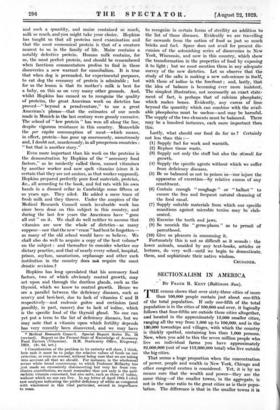SECTIONALISM IN AMERICA
_ By FRANK R. KENT (Baltimore Sun).
than 100,000 people contain just about one-fifth of the total population. If only one-fifth of the total population is in the cities of 100,000 and over, it 'logically follows that four-fifths are outside these cities altogether, and located in the approximately 15,000 smaller cities, ranging all the way from 1,000 up to 100,000, and in the 1110,000 townships and villages,- with which the country is thickly spotted, containing less than 1,000 persons. Now, when you add to this the seven million people who live on individual farms you have approximately 82,000,000 (out of our 112,000,000 total) who live outside the big cities. rrHE census shows that over sixty-three cities of more That seems a huge proportion when the concentration of power, people and wealth in New York, Chicago and other congested centres is considered. Yet; it is by no means sure that the wealth and power—they are the same thing—of the smaller towns, in the aggregate, is not in the same ratio to the great cities as is their popu- lation. The difference is that in the smaller towns it is less active and less informed and effective. It is latent, scattered and unorganized, but it is there; aiia when, as not infrequently happens, a single political note, to which small town people simultaneously respond, is struck, these people have their easy way with the rest of the country. That is what happened in the matter of Prohibi- tion. An insight into the church-going psychology of the ;small American town very clearly reveals the reasons not only why Prohibition was adopted in America but why, :notwithstanding the open and scandalous violations of 1the law in all parts of the country, and the howls of the big city newspapers for a modification of the Act, no modification can be secured. The truth is that four-fifths of America is dry in sentiment, if not in actual practice, sand its small-town heart will not permit any " back tracking " on the liquor question.
Recently I seized an opportunity to make a tour of the .country, from coast to coast, keeping, so far as I could, outside. of the big towns and coming into as close and ;direct a contact as possible with a small part of that four-fifths referred to above. It has been an extra- ordinarily interesting experiment and has disclosed a number of significant things, upon which there is not now space to remark. One development, however, concerning which I do want to speak, is the amazing degree in which the cleavage in American public opinion has in recent years become sectional rather than religious or racial. Under , the curious American constitutional provisions this fact brings about a unique .situation in the govern- ment in. Washington.
Briefly, here it is. Sentiment in the East, which is not only the most populous part of the country, but is the district where the great bulk of financial and industrial resources is located, is decidedly Conservative. In all the great Eastern cities, which in this territory dominate the States, opinion is thoroughly " wet." This is true of both the Democratic and Republican parties, between whom in the East there is at present no outstanding issue. In the South and West sentiment is not only overwhelm- ingly " dry," but markedly progressive, or, as the Conser- vative East would describe it, Radical. Now, under the Constitutional provisions for the election of the President the territory east of the Missouri River and north of the Mason-Dixon line, except on a fluke, will always control the Presidency and elect to that office a man acceptable to Eastern sentiment. The reason is that the States are entitled to representation in the Electoral Colleges in proportion to their population, and this fact gives the East control of the situation.
But when it comes to the United Stites Senate, a totally different situation is found. There the representation of the States is not at all in proportion either to their size or their population. On the contrary, the little and sparsely populated States have just as much voice as the great and populous ones. Each has two Senators, no more and no less. This means that the section of the country west of the Missouri River, although containing less than sixteen million people, has thirty-four of the ninety-six members of the Senate. Add that number to the Senators from the South, and the West and South have easy control over the Senate. By combining at any time and on any question they have a clear majority over the East.
The point of all this is that it creates a situation that makes for deadlocks and futility. The Conservative East, under this system, will always have the Executive branch of the Government, but the Radical or Progressive South and West, in control of the Senate, will always be able to prevent the enactment of Eastern policies that are not in accord with West and South sentiment. It ,does not, of course, mean that government necessarily must come to a halt. There will always be political compromises, and particularly dominant and skilful Executives may even find ways of circumventing sectional opposition. Then, too, it is not on all issues or all measures that the sectional lines are drawn. The division, however, is so deep and so patently spreading that thoughtful men see in the situation many menacing aspects. When you read some of the demagogic tirades of one section against another, you feel as if the country were too big to be comfortable.



































 Previous page
Previous page